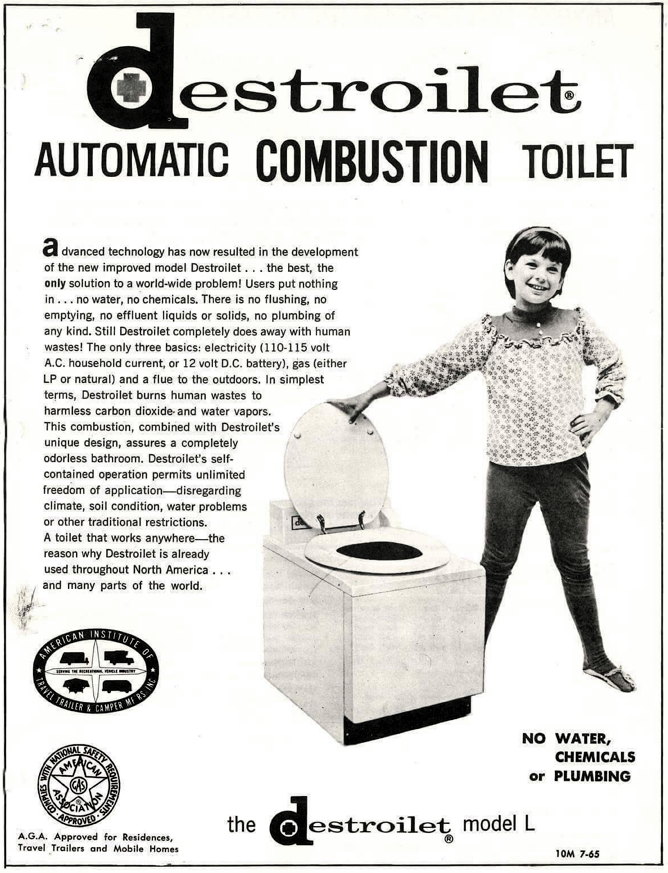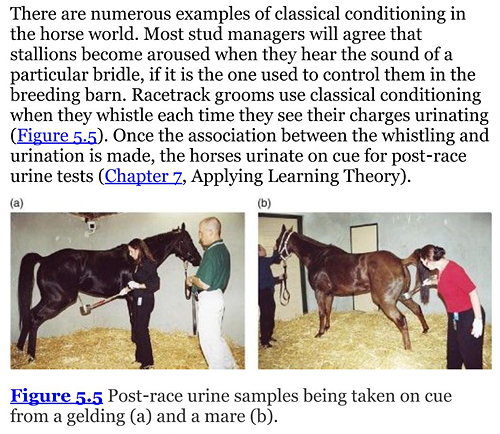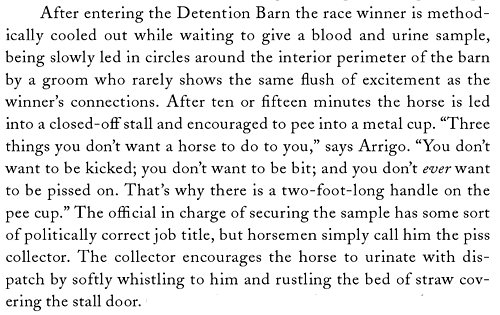Body Fluids
The Destroilet Automatic Combustion Toilet
The Destroilet was the first commercially successful incinerating toilet. They were sold in the 1960s and 70s, but after that the company seems to have gone out of business. Incinerating toilets, however, can still be bought.
image source: kohoso.us
More info from Lifting the Lid: An ecological approach to toilet systems (1999), by Peter Harper and Louise Halestrap:
Disadvantages:
- an electricity connection is needed
- electricity consumption potentially significant – often the toilet will become the largest-consuming appliance in the house
- they are vulnerable to SHOCK LOADS – there is an upper limit to the rate at which it can accept inputs over a short period
- problems often arise if the unit is not in continual use
- the product may be hygienic when removed, but may not be actually composted and requires further treatment to become stable
- there is a risk of total failure in the event of an extended power-cut
Sometimes such compact electrical toilets are the best and only solution, but in practice users are often dissatisfied. The units are very sensitive to misuse – readily overwhelmed by a serious party, for example. Re-commissioning after a breakdown is not a job for the faint-hearted. A common problem arises when the units are installed in holiday-homes and are left for long periods without use. The de-watering process can sometimes transform a mixture of toilet paper, urine and faeces into a kind of paper mâché that coats the innards of the toilet so tenaciously that it is almost impossible to remove. Its strength is so impressive one imagines there could be industrial applications for it.
Posted By: Alex - Sat Oct 21, 2023 -
Comments (1)
Category: Bathrooms, Body Fluids, Excrement
Jalaproctitis
Jalaproctitis is the medical term for the rectal burning sensation often experienced by people when they defecate after having eaten jalapenos. It was given this name by researchers at the University of Texas who conducted an experiment to study the effects of jalapenos (whether it acted as an expectorant, caused painful urination, and burning defecation). From the New England Journal of Medicine (Nov 16, 1978):After giving informed consent, subjects consumed as many large jalapenos as could be tolerated in a three-minute period. The number of peppers consumed ranged from three to 13, with a median of five. Three of the participants noted lacrimation and rhinorrhea immediately after the contest. In none did cough or sputum production develop. One male subject complained of dysuria, and four of five noted a burning discomfort on defecation within 24 hours of the contest.
The limited information obtained from this study does not indicate clinical usefulness of jalapeno as an expectorant. We believe that jalapenos may well be the cause of transient dysuria and, in addition, may result in a syndrome of burning defecation that might appropriately be termed "jalaproctitis."
Posted By: Alex - Sat Mar 18, 2023 -
Comments (3)
Category: Food, Experiments, Body Fluids, Excrement, Pain, Self-inflicted and Otherwise
Poronkusema
As explained by Ziya Tong in The Reality Bubble: how science reveals the hidden truths that shape our world (2019):I found a Finnish-language book titled Poronkusema, but the google-translated blurb is somewhat incomprehensible and doesn't mention anything about urinating reindeers.

Posted By: Alex - Wed Dec 07, 2022 -
Comments (4)
Category: Animals, Instruments and Measuring Devices, Body Fluids
Knocked unconscious by falling urine
The Argus reports that "A builder was knocked unconscious when he was hit with a bottle of pee which dropped from a 50-metre crane."The story reminds me of a viral image that circulated widely about 20 years ago, claiming to show a woman "pierced by a shaft of frozen urine." (The image was a hoax).

Posted By: Alex - Fri Aug 12, 2022 -
Comments (2)
Category: Accidents, Body Fluids
Lactation Cookies
'Lactation Cookies' are cookies that supposedly help to boost milk production in nursing mothers. Recipes vary, but the main ingredient seems to be oatmeal. So, they're essentially oatmeal cookies.I heard about them for the first time yesterday, but they've been around for a number of decades. The oldest reference to them I could find was in a 1974 zoo keepers journal discussing ways to increase milk production in orangutans. However, interest in them has spiked in the last decade, and there are now bakeries that specialize in making them, such as here and here.

Do lactation cookies actually work? The jury is still out on that question. Wikipedia, in its article on galactogogues (lactation inducers), notes that "Herbals and foods used as galactogogues have little or no scientific evidence of efficacy." But on the other hand, what harm can an oatmeal cookie do? And maybe they'd work via the placebo effect.
Incidentally, Guinness beer has also long been rumored to induce lactation and was often given to nursing mothers in Ireland.
Posted By: Alex - Thu Aug 04, 2022 -
Comments (5)
Category: Babies, Food, Body Fluids, Pregnancy
Period Crunch
I doubt you'll be able to buy this new cereal at your local grocery store anytime soon. It's raspberry-flavored, uterus-shaped, and turns the milk red when poured into the bowl.It's the creation of health brand Intimina who are hoping to "fight the stigma around menstruation." They note that 77% of the people they surveyed had "never talked about anything to do with menstruation at the place where the whole household regularly sits down and talks together: the kitchen table." This cereal aims to change that.
More info: Intimina.com

Posted By: Alex - Tue Jun 07, 2022 -
Comments (4)
Category: Cereal, Body Fluids, Blood
Whistle-Trained Horses
Odd fact: Race-horse trainers teach the horses to urinate when they hear a whistle, in order to make the process of post-race urinalysis easier.
Source: Equitation Science, 2nd ed.

Source: The Blue Collar Thoroughbred
Posted By: Alex - Sat May 07, 2022 -
Comments (0)
Category: Animals, Body Fluids
The Comparative Grossness of Snot-Eating
In her 2007 article "Eating Snot - Socially Unacceptable but Common: Why?", Spanish researcher Maria Jesus Portalatin posed the question of why french kissing is considered less gross than eating one's own snot:She seems to imply that french kissing is actually grosser than snot-eating.
Later, in the same article, she explains the appeal of snot-eating:
Her article can be found in the book Consuming the Inedible: Neglected Dimensions of Food Choice, which you can read on loan from archive.org.

Posted By: Alex - Fri Jan 28, 2022 -
Comments (4)
Category: Body Fluids, Nausea, Revulsion and Disgust
Urinary Incontinence Jeans
The Wet Pants Denim company is hoping to capitalize on a new fashion trend "wherein [people] pee their pants because they like the way it looks". The company is offering jeans that give the appearance of urinary incontinence, without the uncomfortable wetness of actual pee.
They're even offering a "white label" urinary incontinence jean, featuring a bright yellow crotch stain.

I'm suspicious that the company is just an elaborate joke. Although they really do seem to be selling these jeans. So maybe not.
These jeans would pair well with those urine-collecting shoes I posted about two days ago.
More info: MEL Magazine, instagram
Posted By: Alex - Tue Jun 01, 2021 -
Comments (8)
Category: Body Fluids, Denim
Urine-Collecting Shoe
Problem: you're out in public and really need to go to the bathroom, but there are no toilets around.Solution: the urine-collecting shoe, patented by Ran Rahimzada in 2008.
As described in his patent:
According to the present invention, a new shoe includes a container to store a person's urine. The person may use a standard catheter, which is connected to the container in the shoe.
This is an unobtrusive device, there is no bag attached to one's foot, etc. The device may be used discreetly, without attracting undue attention.

Posted By: Alex - Sun May 30, 2021 -
Comments (1)
Category: Inventions, Patents, Body Fluids, Shoes

| Who We Are |
|---|
| Alex Boese Alex is the creator and curator of the Museum of Hoaxes. He's also the author of various weird, non-fiction, science-themed books such as Elephants on Acid and Psychedelic Apes. Paul Di Filippo Paul has been paid to put weird ideas into fictional form for over thirty years, in his career as a noted science fiction writer. He has recently begun blogging on many curious topics with three fellow writers at The Inferior 4+1. Contact Us |




